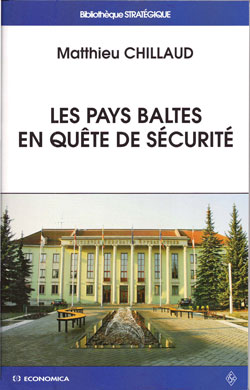 This information has been archived for reference or research purposes.
This information has been archived for reference or research purposes.
Archived Content
Information identified as archived on the Web is for reference, research or recordkeeping purposes. It has not been altered or updated after the date of archiving. Web pages that are archived on the Web are not subject to the Government of Canada Web Standards. As per the Communications Policy of the Government of Canada, you can request alternate formats on the "Contact Us" page.
Book Reviews

Les Pays Baltes en QuÊte de SÉcuritÉ
Reviewed by Frederic Labarre
For more information on accessing this file, please visit our help page.
LES PAYS BALTES EN QUÊTE DE SÉCURITÉ
by Matthieu Chillaud
Paris : Economica, 2009
313 pp, € 29
ISBN 978-2-7178-5687-3
Reviewed by Frederic Labarre
Dr. Chillaud’s work is an important contribution to the constructivist tradition of security policy analysis of small states. In addition to being one of the rare works concerned with the comprehensive security of the Baltic States (meaning both ‘hard’ and ‘soft’ conceptions of security) in the French language, the subject of the book is extremely relevant to current events – indeed, to the difficulties faced by the countries bordering Russia.
The most refreshing aspect is undoubtedly the constructivist tone given to the argumentation. Even if the author is inspired by the theories of realists such as Robert Jervis to help explain the orientation and formulation of policy in the Baltic States, these policies are so intimately linked to the survival of identity that culture and identity determine interests. This is a central tenet of the constructivist perspective.
From the point of view of a chronicle, this book is a testimony to the skill with which the Baltic States have navigated the perils of regional security policy and the agenda of great powers. As such, it corrects the notion that small states are without recourse in the pursuit of their security and the preservation of their independence.
There are very few shortcomings here, and some cannot be attributed to the author. For example, formatting and typographical mistakes (although few) are clearly the responsibility of the publishing house. Similarly, failure to mention the Kievenaar Report – a document addressing the military security of the Baltic States relative to Russia in the late 1990s – cannot be blamed on Chillaud, as this relatively well-known document remains for the initiated only.
However, the author could have insisted more upon the role played by certain non-military institutions in the promotion and internationalization of Baltic security grievances. The importance of Radio Free Europe/Radio Liberty (RFE/RL) and the Voice of America during the period of NATO accession cannot be discounted. As a matter of fact, Paul Goble, one of the more vocal proponents of the Baltic cause, was recently decorated for his efforts as part of the RFE/RL team.
An important section of the work discusses the Russian-speaking minorities, and how the governments of the Baltic countries (especially Estonia and Latvia) have ‘bent over backwards’ to accommodate accusations of discrimination. The analysis of how the Baltic States managed to progress on the tightrope of human and political rights without falling into the abyss of ethnic conflict, or becoming victim to the actions of a fifth column, would have added value. Indeed, a deeper discussion of how Russian Minister of Foreign Affairs Andrei Kozyrev received the Baltic concessions on minority rights through the 1990s would alert the reader unfamiliar with the topic of certain trends in Russian policy-making and strategy. Similarly, these trends should have been connected more precisely with the provision to the Baltic States of the Membership Action Plan (MAP) at the 1999 NATO Summit in Washington, DC. There is merit in recognizing the courage with which the Baltic States have tackled these issues relative to, say, the Balkans, which did not do so.
Finally, the military aspect of the analysis of Baltic security is essential when one considers the issue of security contributions versus consumptions by the new members is sparsely treated. This is also due to the fact that the Baltic States, during the period of time under review by Dr. Chillaud, had to generate costly material solutions to their security, relative to the areas needing to be defended and the availability of financial resources. A greater display of the travails of force generation and of the efforts deployed in Iraq and Afghanistan could have been done. The Baltic States have developed, in some cases, original solutions and niche capabilities during the last 15 years. These successes are important to highlight relative to an ‘out-of-area’ policy of NATO.
This important contribution to the literature of the Baltic States is a synthesis that deepens in many respects the analyses available in the specialized media about this region of the world. It enhances our understanding of how intangible concepts, such as identity and culture, can be ‘operationalized’ for the sake of security policy planning and implementation.
![]()
Frederic Labarre is Head of the Department of Political and Strategic Studies at the Baltic Defence College in Tartu, Estonia.






